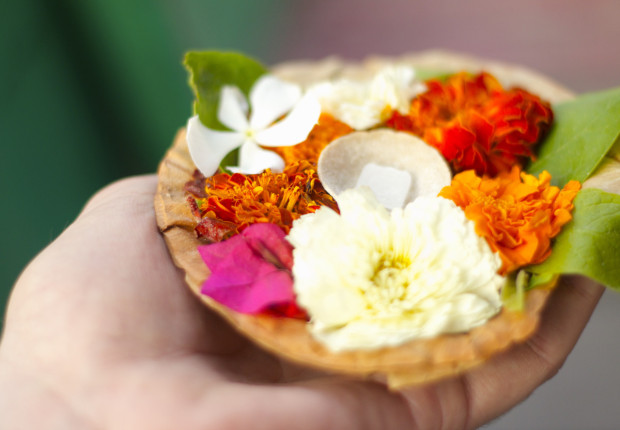AHMEDABAD – For most of this trip our leaders have been Professors Trivedi and Goldman, but on this day, our eighth in India, our true leader was Sharma Mikaram, the 58-year-old Indian bus driver who has been at the wheel since we arrived one week ago.
It was Mikaram who decided when we should leave Rishikesh this morning and whether or not we had time to stop for a bathroom break during the six-hour journey. His mission was anything but simple: get us to Delhi in time for our 6:10 p.m. Air India flight to Ahmedabad, the largest city in the Indian state of Gujarat with nearly 6 million people.
Mikaram even offered a prayer to the deities that hang on the wall of the bus over the driver’s seat that we would make it to Delhi on time – and in safety. The gods are Vishnu, baby Krishna and another deity whose name he doesn’t know.
“Someone gave the third picture to me so I just put it along the other two,” said Mikaram, who identifies himself as a devotee of Vishnu.
Our bus, a 40-seat behemoth with the words “Tourist” emblazoned over the windshield is over-sized among the rickshaws, bicycles, motorscooters and horse-drawn carts that dominate the roads of India. Even before today’s journey, we spent 32 hours in the past week on the bus, which has become our rolling classroom. We’ve used it to “unpack” our meetings with imams, gurus, politicians, priests and journalists, discussing everything from aarti rituals to nationalism. We also spent numerous hours struggling to catch some sleep, but by now, I can’t tell which agonizes me more–insomnia or waking up with a stiff neck.
Mikaram, has been crucial to our safe and fruitful trip so far. He navigates the city roads through sprawling traffic of cars and rickshaws as well as the dusty two-lane country roads with speedy trucks loaded with sugar canes. He is a man with a warm smile and is a patient and efficient driver.
Mikaram, who is from Himachal Pradesh, has been a bus driver for 40 years. He doesn’t use maps or a GPS to get around, he said. The map of India is apparently imprinted in his head.
We were 15 minutes late in getting on the bus this morning, and Mikaram was not pleased. There is rarely a good reason to be late but lingering by the Ganges may be almost good enough. The spring breeze is not the only luxury the Ganges offer to the reporters from New York.
Yasmine tried to explore all the delights before we left – morning rituals, yoga and dipping in the Ganges. She got up at 6 a.m. and participated in a sunrise aarti ritual in the backyard of our hotel. The aarti , with only four participants, was far more intimate compared to the sunset ritual we joined the night before, performed by a guru and his American assistant.
A group of us were up early for yoga at 7 a.m., but the yoga instructor failed to materialize (we didn’t realize that we had to order one at the front desk the night before), but that didn’t stop our yoga enthusiasts. Yasmine and six other seminar members improvised their yoga routines. Professor Goldman was even in the mix, doing some morning stretches and exercises.
After yoga and breakfast, Yasmine went to the Ganges with Olivia and Darcy. All of the male students went for a swim, too. Sam finally let go of his puja flowers in the Ganges. He had bought the small flower plate for 10 rupees during last night’s aarti and carried them with him everywhere he went. After offering the flowers, he used a 500 ml water bottle to take some of the holy water back to New York. (Good luck with airport security, Sam.)

A diya made of dried leaves and flowers is used as an offering during the sunset aarti. Sam waited until we were leaving Rishikesh to let the diya drift away on the Ganges. Photo by Sam Steinberger.
Our mini-vacation from the neck-breaking reporting week resulted in 15 minutes of anxious waiting for our driver Mikaram. He thought we may not be able to make the flight, and he would have to drive us to Ahmedabad, a 600-mile journey.
Despite our growing trust with Mikaram, the words exchanged with him have been limited to “namaste” and “shukriya” (“hello” and “thank you” in Hindi).
As a father of two, Mikaram also prays for his family, his health (so that he can keep providing for the family) and his children’s work. One of his sons is an accountant and the other is a chef at a five-star hotel.
Always busy on the road, Mikaram has no time to perform Hindu rituals. The week before we met, he drove 36 hours from Delhi to Ahmedabad, only taking occasional breaks for chai.
“If I had to get there, I had to get there,” said Mikaram.
After 40 years of safe driving, the veteran driver believes that just the faith he has in God is enough to protect him.
Either Vishnu answered his prayers or the reporting gods answered ours because we boarded the flight and left Delhi at 8:20 p.m., without any extended farewell ceremony to the Ganges, which we came to love during our short visit. We are off to new adventures in a new city, Ahmedabad.